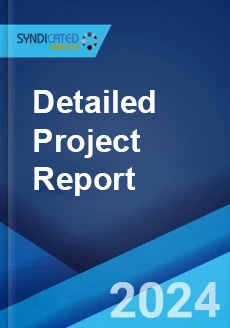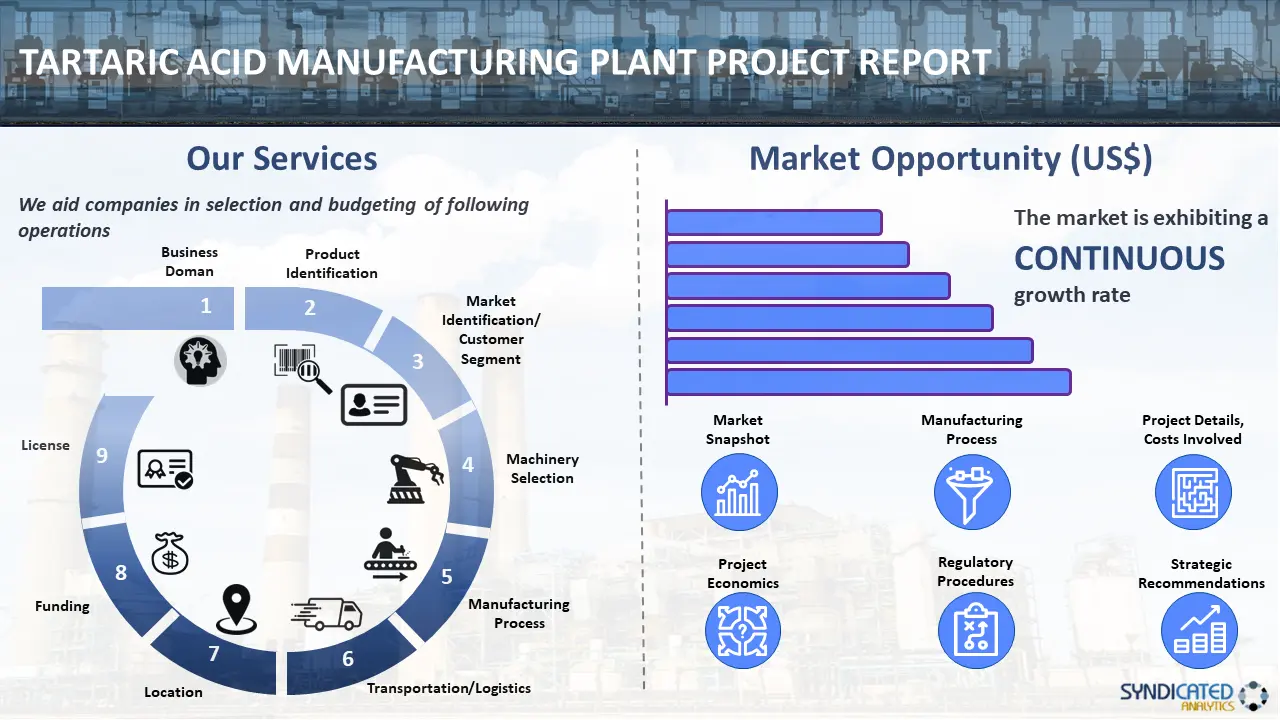
Tartaric Acid Manufacturing Plant Project Report 2025 Edition
Report Coverage: Industry Analysis (Market Performance, Segments, Price Analysis, Outlook), Detailed Process Flow (Product Overview, Unit Operations, Raw Materials, Quality Assurance), Requirements and Cost (Machinery, Raw Materials, Packaging, Transportation, Utility, Human Resource), Project Economics (Capital Investments, Operating Costs, Profit Projections, Financial Analysis, Revenue), and Investment Opportunities
Report Overview:
The new report conducted by Syndicated Analytics, titled “Tartaric Acid Manufacturing Plant Project Report 2025 Edition: Industry Analysis (Market Performance, Segments, Price Analysis, Outlook), Detailed Process Flow (Product Overview, Unit Operations, Raw Materials, Quality Assurance), Requirements and Cost (Machinery, Raw Materials, Packaging, Transportation, Utility, Human Resource), Project Economics (Capital Investments, Operating Costs, Profit Projections, Financial Analysis, Revenue), and Investment Opportunities ,” offers a comprehensive guide for establishing a manufacturing plant in the tartaric acid industry. It encompasses a wide-ranging market overview and delves into specific details such as unit operations, raw material requirements, utility needs, infrastructure prerequisites, machinery and technology specifications, workforce demands, packaging prerequisites, transportation logistics, and more.
Furthermore, this report delivers extensive insights into project economics, including capital investments, project financing, operating costs, income and expenditure forecasts, fixed versus variable expenses, direct and indirect outlays, expected return on investment (ROI), net present value (NPV), profit and loss analysis, and comprehensive financial assessment.

Market Analysis
| Current Demand for Tartaric Acid | The report evaluates the existing global demand for tartaric acid. |
| Growth Prospects and Trends | The study delves into the growth prospects and emerging trends within the tartaric acid market, providing insights to guide strategic decision-making. |
| Leading Segment and Regional Analysis | This study presents a concise overview of the key segments and regional influence in the tartaric acid market, providing a comprehensive view of the industry's overall landscape. |
| Competitive Landscape | An analysis of the competitive landscape highlights key players in the tartaric acid manufacturing industry, shedding light on their strategies and market positioning. |
A. Introduction
Tartaric acid represents a naturally occurring organic acid found in various plants, particularly in grapes, bananas, and tamarinds. It is a dicarboxylic acid denoted with the chemical formula C4H6O6, which is commonly used in food and beverages for its sour taste and as an acidulant. Tartaric acid is a major component of wine sediment, known as tartar or cream of tartar, which develops during the fermentation process. It is mainly used in the production of candies, soft drinks, and gelatin desserts, among other products. Additionally, tartaric acid is extensively utilized in baking powders, where it reacts with sodium bicarbonate (baking soda) to produce carbon dioxide gas that makes the dough rise. It also functions as a component of cleaning solutions for wine-making equipment. Moreover, tartaric acid finds widespread applications in the pharmaceutical and cosmetic industries as an excipient in capsules and tablets and as an ingredient in skincare products.
B. Market Trends/Drivers
The market for tartaric acid is primarily driven by its extensive utilization as an acidulant in the food and beverage industry. Besides this, the escalating product demand in the wine sector for the acidification and pH adjustment of wines is augmenting the market growth further. Moreover, the growing popularity of tartaric acid in baking powders that are essential for the leavening of baked goods is also catalyzing the market globally. Apart from this, the elevating product requirement in the pharmaceutical industry as an excipient in capsules and tablets, owing to the aging population and the high prevalence of chronic diseases, is positively influencing the demand for tartaric acid. Furthermore, the widespread adoption of this compound in the cosmetics industry for skincare derivatives, on account of the changing beauty trends, the rising focus on health and wellness among consumers, the increasing need for natural and organic ingredients, and the expanding efficient supply chain management and distribution networks are anticipated to propel the growth of the tartaric acid market forward over the forecasted period.
Apart from this, the rising popularity of vegan and vegetarian lifestyles, augmenting the demand for natural food additives, is providing a thrust to the market growth. In addition to this, the increasing utilization of tartaric acid in the construction industry for gypsum and cement manufacturing is contributing to the market growth. Additionally, the imposition of several government regulations and the rising consumer demand for clean labels and natural ingredients in food products are driving the market growth. Besides this, the burgeoning health and wellness sector, amplifying the need for tartaric acid in dietary supplements and health foods due to its weight management and antioxidant properties, is boosting the market growth.
Market Coverage:
| Current Demand for Tartaric Acid | The report evaluates the existing global demand for tartaric acid. |
| Growth Prospects and Trends | The study delves into the growth prospects and emerging trends within the tartaric acid market, providing insights to guide strategic decision-making. |
| Leading Segment and Regional Analysis | This study presents a concise overview of the key segments and regional influence in the tartaric acid market, providing a comprehensive view of the industry's overall landscape. |
| Competitive Landscape | An analysis of the competitive landscape highlights key players in the tartaric acid manufacturing industry, shedding light on their strategies and market positioning. |
Project Feasibility
| Technical Feasibility | The study outlines the intricacies of tartaric acid manufacturing, outlining the necessary equipment and technological requirements. A clear description of the manufacturing process is provided. |
| Financial Feasibility | The report presents an in-depth financial analysis, including the initial investment required, income and profit projections. These financial insights aim to assist potential investors in assessing the viability of the project. |
| Environmental and Regulatory Considerations | The report also discusses the environmental and regulatory aspects associated with tartaric acid production, ensuring that the project aligns with sustainability and compliance standards. |
Project Implementation
| Location Selection | Choosing the optimal location for the manufacturing plant is crucial. This section explores location-based factors impacting the project's success. |
| Plant Design and Layout | Detailed plant design and layout plans are presented, emphasizing efficient production processes and workspace ergonomics. |
| Procurement of Raw Materials | An overview of the procurement process for raw materials necessary for tartaric acid production is provided, ensuring a smooth supply chain. |
| Production Process | An explanation of the tartaric acid production process is provided in the study, from raw material input to the final product, highlighting key stages and quality control measures. |
| Quality Control Measures | Stringent quality control measures are outlined to ensure the production of high-quality tartaric acid. |
Risk Analysis
| Identification of Potential Risks | Potential risks associated with the project are identified, allowing for proactive risk management strategies. |
| Risk Mitigation Strategies | The report proposes risk mitigation strategies to minimize the impact of identified risks on the project's success. |
Seeking a Tailored Project Report?
While we have endeavored to create a comprehensive report, we acknowledge that each stakeholder may possess unique requirements. In light of this, we offer the option to customize the report to align with your specific needs. You can convey your business specifications to our consultants, and we will furnish you with a personalized scope tailored precisely to your requirements. Some of the common customizations that our clients often request include:
- Tailoring the report to suit the country/region where you intend to establish your plant.
- Adapting the manufacturing capacity of the plant to meet your specific needs.
- Customizing machinery suppliers and costs to align with your requirements.
- Incorporating any additional elements into the existing scope as per your specifications.
Report Scope:
| Features | Details |
|---|---|
| Currency | US$ (Information can also be provided in the local currency) |
| Pricing and Purchase Options | Single User License: US$ 3450 Five User License: US$ 4450 Corporate User License: US$ 5450 |
| Customization Scope | The report can also be customized based on the requirements of the customer. |
| Post-Sale Analyst Support | 12-14 Weeks |
| Delivery Format | PDF and Excel through email (We can also provide the editable version of the report in PPT/Word format on special request) |
Questions Addressed in the Report:
- What has been the performance of the tartaric acid market to date, and what are the projections for its future growth?
- How is the tartaric acid market segmented globally?
- How is the tartaric acid market distributed across various regions?
- What trends are observed in the pricing of different feedstocks within the tartaric acid industry?
- What constitutes the structure of the tartaric acid industry, and who are its major stakeholders?
- What key operations are necessary for manufacturing tartaric acid?
- How much land is required to establish a tartaric acid manufacturing plant?
- What is the planned layout for a tartaric acid manufacturing plant?
- What equipment is essential for starting a tartaric acid manufacturing plant?
- What materials are needed to begin production in a tartaric acid manufacturing plant?
- What are the packaging necessities for a tartaric acid manufacturing plant?
- What transportation logistics are required for a tartaric acid manufacturing plant?
- What utilities are needed to operate a tartaric acid manufacturing plant?
- What staffing is necessary for the operation of a tartaric acid manufacturing plant?
- What are the estimated infrastructure costs for establishing a tartaric acid manufacturing plant?
- What initial investments are necessary for setting up a tartaric acid manufacturing plant?
- What will the ongoing operational expenses be for a tartaric acid manufacturing plant?
- How should be the pricing structure for the final product in the tartaric acid industry?
- What are the expected revenues and costs associated with running a tartaric acid manufacturing plant?
- How long will it take for the plant to reach the break-even point?
- What are the forecasted profits from establishing a tartaric acid manufacturing plant?
- What factors determine success and what risks exist in the tartaric acid industry?
- What regulations must be complied with to establish a tartaric acid manufacturing plant?
- What certifications are necessary to operate a tartaric acid manufacturing plant?
Why Choose Syndicated Analytics:
- Our reports offer valuable insights to stakeholders, enabling them to make informed business decisions confidently.
- We maintain a robust network of consultants and domain experts spanning over 100 countries across North America, Europe, Asia Pacific, South America, Africa, and the Middle East.
- Our extensive database includes equipment, and raw material suppliers from major continents, ensuring comprehensive coverage.
- We diligently track and update critical factors such as land costs, raw material costs, construction costs, utility expenses, labor costs, and more, across more than 100 countries worldwide.
- Syndicated Analytics is the trusted partner of choice for leading corporations, governments, and institutions globally. Our clientele ranges from small startups to Fortune 500 companies.
- Our dedicated in-house team comprises experts in various fields, including engineers, statisticians, modeling specialists, chartered accountants, architects, and more. They play a pivotal role in developing, expanding, and optimizing sustainable manufacturing facilities worldwide.
Purchase Options
Ask For Customization
Personalize this research
Triangulate with your own data
Get data as per your format and definition
Gain a deeper dive on a specific application, geography, customer or competitor
Any level of personalization
Get in Touch
Call us on
US: +1-213-316-7435
Uk: +44-20-8040-3201
Drop us an email at
sales@syndicatedanalytics.com